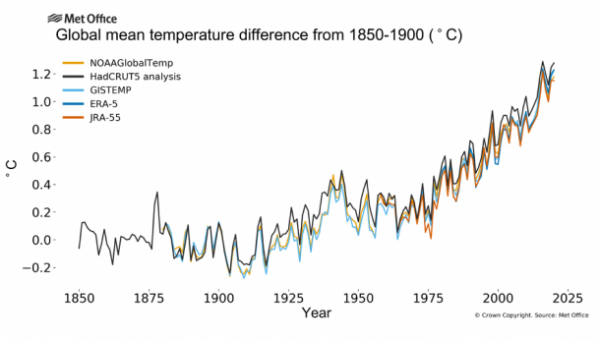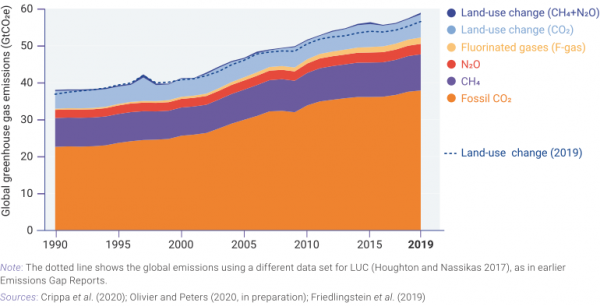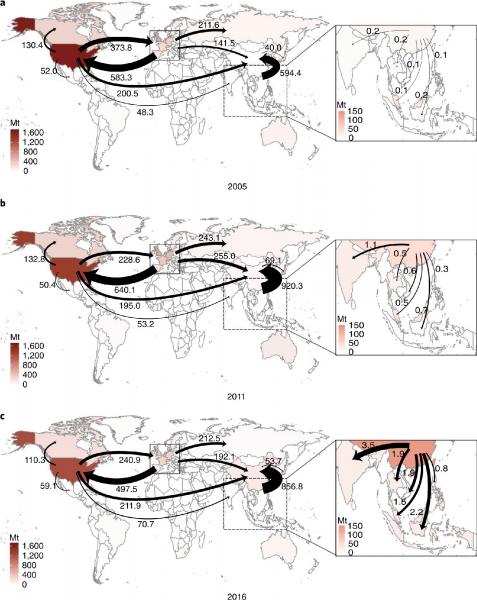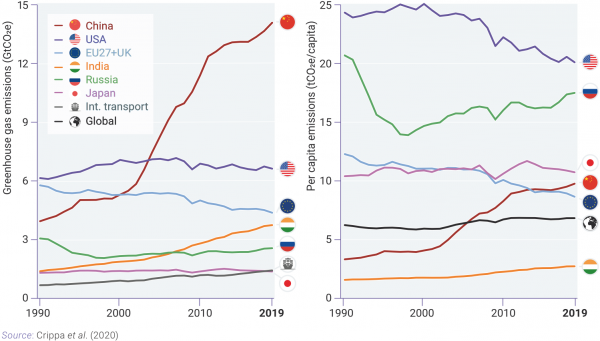Introduction: As the UN Secretary-General António Guterres said: "Covid and climate have brought us to a threshold." Global warming, like the new crown epidemic, has brought a huge impact on our lives. Facing the trend of global warming, restricting carbon emissions is the key. The whole world is calling for carbon emission reduction actions. It is not so much an action to save the earth as a self-help action for human beings. Affected by greenhouse gas emissions, global warming is still on the rise. According to data from the World Meteorological Organization1, in the sustained long-term...
As the UN Secretary-General António Guterres said: "Covid and climate have brought us to a threshold." Global warming, like the new crown epidemic, has brought a huge impact on our lives. Facing the trend of global warming, restricting carbon emissions is the key. The whole world is calling for carbon emission reduction actions. It is not so much an action to save the earth as a self-help action for human beings.
Global warming is still on the rise due to greenhouse gas emissions
According to data from the World Meteorological Organization1, under the continuing long-term climate change trend, 2011-2020 was the warmest decade on record, with 2016, 2019 and 2020 among the top three. The global average temperature in 2020 is about 14.9°C, which is 1.2(±0.1)°C higher than the pre-industrial (1850-1900) level. It can be seen from this that neither the economic delay caused by the new crown epidemic nor the La Ni?a event has weakened the trend of global warming.

Figure 1 Global annual mean temperature difference compared to pre-industrialization (1850-1900)
One of the main causes of global warming is greenhouse gas emissions, and the UN Environment Programme's Emissions Gap Report 20202 shows that although greenhouse gas emissions fell in 2020 compared to 2019, atmospheric Greenhouse gas concentrations in China continue to rise, and the impact of the new crown epidemic on climate change is negligible. The main components of greenhouse gases are carbon dioxide, methane, etc. (Figure 2). Therefore, one of the important measures to slow down the global warming trend is to control carbon emissions.

Figure 2 Composition of global greenhouse gas emissions
Plans to control carbon emissions, vulnerable to policy changes
Support for carbon emission reduction actions is inseparable from government initiatives and policy formulation at this stage. However, it does not seem easy to ensure that the policy plan is carried out on schedule. For example, the United States signed the Paris Agreement on April 22, 2016, during the Obama administration. In June 2017, the Trump administration, which once again raised the slogan "MAGA" (Make America great again), announced that the United States had withdrawn from the Paris Agreement3. That same year, it announced that it would scrap the Clean Power Plan and replace it with the Affordable Energy Plan. The move is intended to remove the burden on businesses from environmental policies and increase employment by increasing the consumption of fossil fuels. In 2021, the Biden administration promised that the United States would return to the Paris Agreement, and proposed the goal of decarbonizing electricity by 2035 and achieving net-zero greenhouse gas emissions by 2050. To achieve "35/50," the Biden administration plans to spend $2 trillion on climate programs.
According to the Emissions Gap Report 2020 released by the United Nations, if the United States adopts the goal of achieving net zero emissions of greenhouse gases by 2050 in accordance with the recommendations of the Biden administration’s climate plan, it will reduce the originally predicted global warming by the end of this century by about 0.6°. C-0.7°C. As the country with the largest per capita carbon emission, the United States is very closely related to the global carbon emission reduction work, but the instability of its policies can easily make it difficult to carry out emission reduction work.
How should the carbon market price be determined, and will it trigger another trade war?
Many economists have said that the essence of carbon neutrality is financial. Globally, there are about 30 countries that price carbon. The World Bank established the Carbon Pricing Leadership Alliance in 2015 to call for the establishment of a global carbon market. As more and more countries around the world pay attention to carbon emissions and the scarcity of carbon emission rights, carbon prices will rise in the future. According to estimates by the High-level Committee on a Carbon Price, to reduce carbon emissions in a cost-effective manner, a carbon price needs to reach at least US$40-80/tCO2 by 2020 and US$50-100/tCO2 by 2030. The International Energy Agency has stated that to meet the Paris Agreement targets, a carbon price needs to be set between US$75 per ton and US$100 per ton5. According to the estimates of the International Monetary Fund, the current global flat carbon price is only US$2/ton6. According to the World Bank report "State and Trends of Carbon Pricing 2020", the median carbon price per ton is US$157.
Due to the different carbon prices in each country, in order to maintain the competitiveness of their own industries, the EU implements a carbon border adjustment policy (Border Carbon Adjustment) for countries that have not enacted carbon taxes. The purpose is to protect European companies that are required to reduce carbon emissions from carbon emissions. The effect of dumping. However, this is inconsistent with the rules of the World Trade Organization (WTO), which has led to a difficult implementation of the mechanism8. There is also the potential to undermine the relationship between international cooperation on climate change, for example by pulling trading partners out of the Paris Agreement. The Economist Brief, published on May 23, 2020, talks about 9, "Rough calculations using OECD data on carbon emissions in international trade, assuming 10 billion euros in imports from China, imports from the US A carbon boundary adjustment fee of EUR 30 per tonne on all goods entering Europe would be equivalent to a tariff of 2.8% and 1.2% respectively. If the price of imports from India was EUR 2 billion, it would be equivalent to 5.1% Tariffs. In all three scenarios, that's roughly equivalent to doubling the existing average tariffs."
The increase in carbon price will help the transformation of the national industrial energy structure and promote carbon emission reduction, but for developing countries, it will limit their economic development. Therefore, it is more difficult for countries to protect their own interests or to globalize carbon pricing.
Does the transfer of carbon footprints of multinational corporations aggravate the carbon reduction tasks of developing countries?
According to a report released by The Guardian in 2019, 10, since 1965, one-third of the world's carbon emissions have been contributed by only 20 companies, most of which are multinational corporations. Multinational corporations reduce their territorial carbon emissions through investment and trade or carbon transfer, where a country transfers domestic production to other countries through cross-border investment. Due to the low cost of land and labor in developing countries, more and more multinational companies are attracted to invest, and the carbon footprint of developing countries is increasing sharply11. Several researchers around the world have shown12 that multinational corporations in developed countries are transferring CO2 emissions to developing countries.
To achieve the goals of the Paris Agreement, it is not enough to simply reduce the carbon emissions of developed countries. It is necessary to keep in mind the community of shared future for mankind, and greenhouse gases will diffuse with the migration of the atmosphere. Multinational companies need to understand their carbon footprint and manage carbon emissions for their domestic and foreign companies and supply chains. This can not only help related companies that are not good at dealing with carbon emissions requirements to solve sustainable management issues, but also pass on to investors and suppliers. Positive consumer information to reduce reputational and investment risk and increase investor and consumer trust.

Note: The color of each country or region represents the total CO2 emissions from FDI stocks from that country or region. Arrows indicate carbon transfers through global foreign direct investment. The width of the arrow indicates carbon flux.
Figure 3 Carbon transfer relationship in global foreign direct investment in 2005, 2011 and 2016 (Source: Zhang et al, 2020)
In the face of carbon emission reduction, all parties need to coordinate and make progress
Affected by the new crown virus, the global economic development has been suspended, and governments of various countries are carrying out economic recovery in an all-round way. Therefore, the opportunity to achieve a low-carbon transformation of the economy has emerged. Countries can formulate more environmentally friendly recovery plans and create more sustainable industrial structure changes. UN Secretary-General António Guterres has called on governments to use the COVID-19 recovery as an opportunity to create more sustainable, resilient and inclusive societies13. To this end, the United Nations Framework Convention on Climate Change (UNFCCC) emphasizes that governments can incorporate nationally determined contributions and long-term mitigation strategies in economic recovery plans and policies.
At present, the top six countries in terms of global greenhouse gas emissions are China, the United States, the European Union and the United Kingdom, India, Russia, and Japan, and the top six countries in terms of per capita emissions are the United States, Russia, Japan, China, the European Union, and India. The emission reduction commitments of the major greenhouse gas emitters are particularly important. At present, these countries have made commitments to reduce carbon emissions.

Figure 4 Absolute GHG emissions (excluding land-use change emissions) and per capita emissions of the top six emitting countries
Although at this stage, the goal of various countries is still to increase the global temperature. But more than 110 countries around the world have pledged to achieve carbon neutrality in the future14, and the latest trends such as the development of the global new energy industry, the reduction of the use of fossil fuels, and the transformation of the shipping industry indicate that everything will be better.
Whether it is to achieve carbon neutrality, solve global warming, or adopt carbon pricing and energy structure upgrades to reduce carbon emissions, all countries in the world need to cooperate and help each other on both the supply side and the demand side. Climate and environmental issues have global and long-term characteristics, and both developed and developing countries have the same goals and different responsibilities. Affected by both the COVID-19 pandemic and the economic recession, carbon reduction efforts will face more difficulties, especially developing countries will face greater pressure to reduce emissions. Therefore, developing countries need more financial and technical assistance support.
In order to promote the achievement of the goals of the Paris Agreement, the United Nations "2030 Agenda" proposes to jointly build a global energy interconnection, promote multilateral cooperation, and jointly build a new pattern of climate and environmental governance. In the process of practice, the role of international organizations can be brought into play, a comprehensive, coordinated and efficient global governance system can be established, a global governance platform with win-win cooperation can be created, and a new situation of global governance with extensive participation of all parties can be realized.
